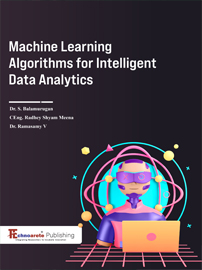Forecasting COVID-19 from Lung X-ray Images
K. Sujatha
Department of Electrical and Electronics Engineering, Dr. M.G.R. Educational and Research Institute, Chennai, Tamilnadu, India
Corresponding Author: sujathak73586@gmail.com
N.P.G. Bhavani
Department of ECE, Saveetha School of Engineering, Saveetha Institute of Medical and Technical Sciences, Chennai. India
Corresponding Author: sbreddy@gmail.com
V. Srividhya
Department of Electrical and Electronics Engineering, Meenakshi College of Engineering, Chennai, India
T. Kalpalatha
Department of ECE, S.V. Engineering College for Women, Karakambadi, Tirupati, India
Corresponding Author:drkalpalatha.thokala@gmail.com
B. Latha
Department of Physics, Dr. M.G.R. Educational and Research Institute, Chennai-600095, Tamilnadu, India
U. Jayalatsumi
Department of ECE, Dr. MGR Educational & Research Institute,Chennai, Tamil Nadu, India
T.Kavitha
Department of Civil Engineering, Dr. MGR Educational & Research Institute,Chennai, Tamil Nadu, India
A. Ganesan
Department of ECE, S.V. Engineering College for Women, Karakambadi, Tirupati, India
Corresponding Author:ragmephd@gmail.com
A. Kalaivani
Department of CSE, Saveetha School of Engineering, SIMATS, Chennai, Tamil Nadu, India
Corresponding Author:kalaivanianbarasan@rediffmail.com
Su-Qun Cao
Faculty of Electronic Information Engineering, Huaiyin Institute of Technology, China
Abstract :
Presently, the diagnosis of Corona Virus – 2019 (COVID-19) is a challenging task worldwide as the disease is spreading at a very faster rate. Several people are detected with COVID-19 and the data analyst say that the rate of spread of the disease is increasing exponentially. This investigation has facilitated the need for diagnosing the disease within a short duration of time from the X-ray images of the lungs. Artificial intelligence like deep learning algorithms is deployed to diagnose COVID-19 by maintaining social distancing. Real time data sets are gathered from the government hospitals for healthy as well as those who are affected by COVID-19. On development of a smart phone Application the patients themselves will record the respiratory sounds. The features are extracted using Discrete Wavelet Transform (DWT), where a threshold is applied to extract useful coefficients used to train the Deep learning Neural Networks (DLNN) using Fast Recurrent Convolutional Neural Networks (F-RCNN). The respiratory audio signals are captured to detect patients affected by Corona Virus by a way of non-contact, non-intrusive approach. This mobile phone App is effective in diagnosing the COVID-19 from the X-ray images of the Lungs. Even low income people can also use this technology. The effectiveness of the proposed system which uses DWT and thresholding has a F-measure of 96–98%. The forecasted results were in the range of 89%-95% for the above said algorithms. It is significant from the above results that the severe impact of COVID-19 can be diagnosed using a non-invasive mobile phone App using X-ray images.
Keywords:
- Artificial Intelligence
- respiratory sounds,
- Convolutional NeuralNetwork,
- COVID-19,
- mobile phone App,
- Discrete Wavelet Transform ,
- Thresholding
Reference
[1] A literature review of 2019 novel coronavirus (SARS-CoV2) infection in neonates and children Matteo Di Nardo, Grace van Leeuwen, Alessandra Loreti, Maria AntoniettaBarbieri, YitGuner, Franco Locatelli and Vito Marco Ranieri. Pediatric research. 2020
[2] Wang, Y., Wang, Y., Chen, Y. & Qin, Q. Unique epidemiological and clinical features of the emerging 2019 novel coronavirus pneumonia (COVID- 19) implicate special control measures. J. Med. Virol. 92, 568–576 (2020).
[3] Clinical and immunological features of severe and moderate coronavirus disease 2019. Chen G, Wu D, Guo W, Cao Y, Huang D, Wang H, Wang T, Zhang X, Chen H, Yu H, Zhang X, Zhang M, Wu S, Song J, Chen T, Han M, Li S, Luo X, Zhao J, Ning Q J Clin Invest. 2020 May 1; 130(5):2620- 2629.
[4] Human Coronavirus in Hospitalized Children with Respiratory Tract Infections: A 9-Year Population-Based Study from Norway. Heimdal I, Moe N, Krokstad S, Christensen A, Skanke LH, NordbøSA, Døllner H , J Infect Dis. 2019;219(8):1198.
[5] Medical reviews.Coronaviruses.Monto AS, Yale J Biol Med. 1974;47(4):234
[6] Coronavirus Occurrence and Transmission Over 8 Years in the HIVE Cohort of Households in Michigan.Monto AS, DeJonge PM, Callear AP, Bazzi LA, Capriola SB, Malosh RE, Martin ET, Petrie JG , J Infect Dis. 2020;222(1):9
[7] Seroepidemiologic studies of coronavirus infection in adults and children.McIntosh K, Kapikian AZ, Turner HC, Hartley JW, Parrott RH, ChanockRM , Am J Epidemiol. 1970;91(6):585
[8] Epidemiology of Seasonal Coronaviruses: Establishing the Context for the Emergence of Coronavirus Disease 2019.Nickbakhsh S, Ho A, Marques DFP, McMenamin J, Gunson RN, Murcia PR , J Infect Dis. 2020;222(1):17.
[9] Clark A, Jit M, Warren-Gash C, Guthrie B, Wang HHX, Mercer SW, Sanderson C, McKee M, Troeger C, Ong KL, Checchi F, Perel P, Joseph S, Gibbs HP, Banerjee A, Eggo RM., Centre for the Mathematical Modelling of Infectious Diseases COVID-19 working group. Global, regional, and national estimates of the population at increased risk of severe COVID-19 due to underlying health conditions in 2020: a modelling study. Lancet Glob Health. 2020 Aug;8(8):e1003-e1017
[10] Human aminopeptidase N is a receptor for human coronavirus 229E. Yeager CL, Ashmun RA, Williams RK, Cardellichio CB, Shapiro LH, Look AT, Holmes KV ,Nature. 1992;357(6377):420
[11] Human coronavirus NL63 employs the severe acute respiratory syndrome coronavirus receptor for cellular entry. Hofmann H, Pyrc K, van der Hoek L, Geier M, Berkhout B, Pöhlmann S, ProcNatlAcadSci U S A. 2005;102(22):7988. Epub 2005 May 16.
[12] Human and bovine coronaviruses recognize sialic acid-containing receptors similar to those of influenza C viruses.Vlasak R, Luytjes W, Spaan W, Palese P , ProcNatlAcadSci U S A. 1988;85(12):4526.
[13] FarhanaParvin, SkAjim Ali, S. Najmul Islam Hashmi, Ateeque Ahmad, Spatial prediction and mapping of the COVID-19 hotspot in India using geo- statistical technique, Korean Spatial Information Society 2021.
[14] Hari Shankar Gangwar, P.K. Champati Ray, Geographic information system-based analysis of COVID-19 cases in India during pre-lockdown, lockdown, and unlock phases, International Journal of Infectious Diseases, 2021.
[15] Ivan Franch-Pardo, Brian M. Napoletano, , Fernando Rosete-Verges, “Spatial analysis and GIS in the study of COVID-19. A review”, Science of the Total Environment, 2020.
[16] Felix Nikolaus Wirth, Marco Johns, Thierry Meurers, Fabian Prasser, “Citizen-Centered Mobile Health Apps Collecting Individual-Level Spatial Data for Infectious Disease Management: Scoping Review”, JMIR MHEALTH AND UHEALTH, 2020.

